Japan's Official Development Assistance White Paper 2011
3. Addressing Global Issues
(1) Environment and Climate Change Issues
International discussions on environmental issues began in the 1970s. Through discussions at the United Nations Conference on Environment and Development (UNCED, also called the Earth Summit) in 1992 and at the World Summit on Sustainable Development (WSSD) of 2002, their importance has been increasingly recognized. At the G8 Hokkaido Toyako Summit held in July 2008, the environment and climate change were taken up as one of the major themes and constructive discussions were held. The entire international community must address the environmental issues to ensure the prosperity of humankind in the future.
<Japan's Efforts>
•Environmental Pollution Control
With Japanese great experience and technology Japan is working for the resolution of pollution issues in developing countries. In particular, Japan supports measures against pollution and the improvement of the living environment in urban areas (measures against air pollution, prevention of water contamination, waste management, etc.), mainly in Asian countries that are achieving rapid economic growth.
•Climate Change
Climate change threatens human security (see the figure on page 32) with disregard for national borders. Because it is an urgent issue for humankind, international community including both developed and developing countries should work together to strengthen measures to address the climate change.
In October 2010, Japan hosted Aichi-Nagoya Ministerial Meeting of the REDD+ Partnership in Nagoya co-chaired by Japan's Minister for Foreign Affairs Seiji Maehara and Papua New Guinea's Minister for Foreign Affairs Trade and Immigration Samuel T. Abal. At the meeting, direction was formulated to accelerate efforts toward the preservation of forests in developing countries (REDD+)*(Note 11), one of the important pillars of climate change. In addition, Japan collaborated closely with the host country Mexico and other countries at the 16th Conference of the Parties of the United Nations Framework Convention on Climate Change (COP 16), resulting in the adoption of the Cancun Agreements that lead to the establishment of a comprehensive international framework, including major greenhouse gas emitters like the United States and China. The Cancun Agreements stipulate the establishment of the "Green Climate Fund" to support developing countries in the field of climate change, and the launch of a transitional committee to design it. Japan hosted the Second Meeting of the Transitional Committee for the design of the Green Climate Fund in Tokyo, July 2011, and has actively contributed to the process of the basic design of this fund in COP17. Further, in 2009 Japan pledged $15 billion up to 2012, including public and private finance to support developing countries that actively making efforts to reduce greenhouse gas emissions and that being particularly vulnerable to the adverse impact of climate change. Japan has already implemented over $12.5 billion as of the end of October 2011.

A Senior Volunteer provides technical guidance for a water quality test at the National Institute of Water in Argentina with equipment provided as part of the "Project on Establishment of Control Capacity for Industrial Wastewater and Water (Project for Technical Capacity Development for Industrial Wastewater and Waste Pollution Mitigation)" (Photo: Shinichi Kuno/JICA)
Additionally, at the Third TICAD Ministerial Follow-up Meeting held in Dakar, the capital of Senegal in May 2011, Japan proposed that African countries formulate their strategy to promote low-carbon growth in Africa, and is supporting to build a low-carbon society in Africa. Moreover, Japan is promoting the "East Asia Low Carbon Growth Partnership" which aims to promote dissemination of low-carbon technologies and achieve both economic growth and measures against global warming in East Asia, which is the world’s economic growth center and also includes the world’s largest emitters of greenhouse gas such as China and India.
Japan made constructive proposals and actively contributed to discussions at COP17, which was held in Durban, South Africa at the end of 2011. This yielded four significant results, namely progress for future frameworks, an agreement towards the establishment of the Second Commitment Period of the Kyoto Protocol, the Green Climate Fund and a series of decisions regarding the implementation of the Cancun Agreements. The basic design of the "Green Climate Fund" was agreed upon, and strides were made towards its establishment.
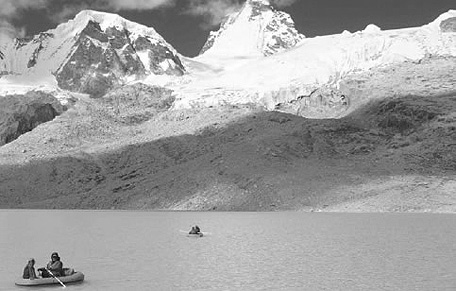
Exploring a glacial lake in Bhutan as part of the "Study on GLOFs (Glacial Lake Outburst Floods) in the Bhutan Himalayas" project (Photo: Jiro Komori)
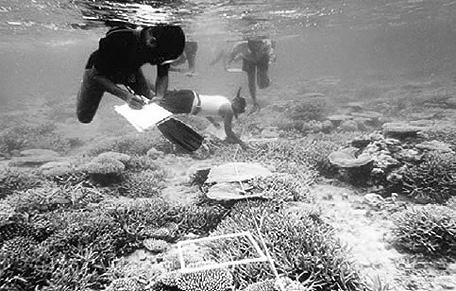
Conducting training on ecological monitoring for local environmental protection staff as part of "The Capacity Enhancement Project for Coral Reef Monitoring" in Palau (Photo: PICRC)
•Biodiversity
The Tenth Meeting of the Conference of the Parties (COP10) to the Convention on Biological Diversity (COP10) and the Fifth Meeting of the Conference of the Parties Serving as the Meeting of the Parties to the Cartagena Protocol on Biosafety (COP-MOP5)* were held in Nagoya, Aichi Prefecture in October 2010. At the meeting, the Aichi Biodiversity Targets (the Strategic Plan for Biodiversity 2011-2020)* which is a global target beginning in 2011 to effectively implement the Convention on Biological Diversity, the Nagoya Protocol*, which specifies concrete measures for Access and Benefit-Sharing (ABS) of genetic resources that should be implemented by each of the party countries, and the Nagoya-Kuala Lumpur Supplementary Protocol* which stipulates the scope of responsibility and response measures when genetically modified organisms have damaged the ecosystem, were adopted. In addition, Japan announced the Initiative to Assist Developing Countries with the Conservation of Biodiversity (Life in Harmony Initiative) to support efforts by developing countries to achieve the Aichi Biodiversity Targets, pledging a total of $2 billion over a period of three years beginning in 2010, for areas that aid in preserving biodiversity. Moreover Japan supported the establishment of the Nagoya Protocol Implementation Fund (NPIF) at Global Environment Facility (GEF) and in 2010 contributed 1 billion yen to the fund in order to support early entry into force and effective implementation of the Nagoya Protocol.
In the future, it will be extremely important to work steadily toward achievement of these goals to conserve biodiversity and ensure its sustainable use.
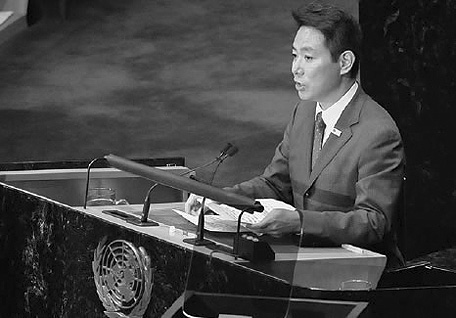
Minister for Foreign Affairs Seiji Maehara speaks as a representative of the COP 10 host country at a High Level Meeting on Biodiversity in the UN General Assembly
Biodiversity

Terminology
*REDD
REDD is a concept for reducing greenhouse gas emissions caused by the deforestation and forest degradation in developing countries, by setting the reference levels, based on the past trend, and giving the incentives to developing countries like financing to achieve reduction. "REDD+" refers to such efforts that also include preservation of forests, sustainable forest management, and increase of forest carbon accumulation.
*Building a Low-Carbon Society
This refers to the achievement of the society with low-carbon emissions through the use of Japan's advanced environmental technologies including the introduction of high-efficiency power station, sustainable forest management, promotion and improvement of systems related with energy-saving, renewable energy, and waste management.
*Aichi Biodiversity Targets
They are also called the "Post 2010 Biodiversity Targets." The medium/long-term goal is to achieve harmony between humans and nature by 2050, with a short-term target of implementing actions to stop the loss of biological diversity by 2020. The Targets consist of 20 individual goals, including the designation and preservation of at least 17% of land areas and 10% of ocean areas as protected areas.
*Nagoya Protocol
A protocol regarding ABS (access and benefit-sharing of genetic resources). It requires the users of genetic resources (plants, animals, and microbes that lead to the development of products such as food and pharmaceuticals) to distribute the benefits of such use to the providers of those resources in a fair manner.
*Cartagena Protocol
The Cartagena Protocol came into force in 2003. It stipulates measures to ensure sufficient protections related to safe transfer, handling, and the use of living modified organisms, to prevent living modified organisms which moved across borders from being released into the nature and adversely affect on the conservation and sustainable use of biodiversity.
*Nagoya-Kuala Lumpur Supplementary Protocol
The Nagoya-Kuala Lumpur Supplementary Protocol specifies "liability and redress" (who is responsible) and stipulates the implementation of response measures such as measures to prevent loss and measures for restoration that must be implemented by the responsible parties, when the maintenance of biodiversity, etc., has been adversely affected by the import and export of genetically modified organisms.
[Brazil]
"Utilization of ALOS Images to Support Protection of the Brazilian Amazon Forest and Combat against Illegal Deforestation"
Technical Cooperation Project (June 2009 - Current)
Brazil's Amazon region is facing a serious problem of decreasing forests due to illegal logging. However, it is not easy to prevent illegal logging in a vast rain forest through ground patrols. To solve this problem, Japan has provided technological aid by using satellites to discover illegal logging in Brazil. Cloud is a big problem which causes blur satellite images during the rainy season, however Japan’s ALOS is equipped with the radar that can penetrate clouds to detect illegal logging during the rainy season when the ground is hidden by clouds.
* ALOS: Advanced Land Observing Satellite
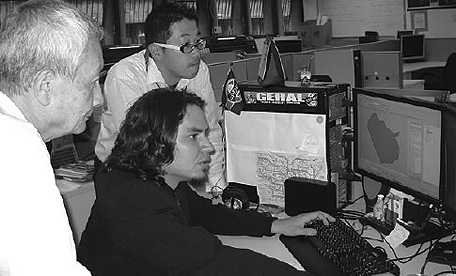
Japanese experts and Brazilian counterparts search for deforested areas (Photo: JICA)
[South Africa]
"Climate Simulation and Projections for Adaptation Impact in the Southern African Region"
Technical Cooperation Project (April 2010 - Current)
In Southern African Region, many people are engaged in agriculture and livestock farming, highly dependent on the natural environment, however, the social infrastructure is not sufficient to deal with natural disasters, thus the region tends to be easily affected by abnormal weather caused by climate change. In this context, research institutes in Japan and the Republic of South Africa are conducting joint research to forecast climate change for the purpose of mitigating the impact of climate change on Southern African Region. This project uses both models of the atmosphere and the ocean affecting the climate of Africa's southern region, to forecast regional climate change, and have been successful in predicting El Niño and other climate change phenomena. In the future, the project aims to further improve the accuracy of climate change forecasts and send weather forecasts to a wide range of local residents, through the Internet, mobile phones, and other means.
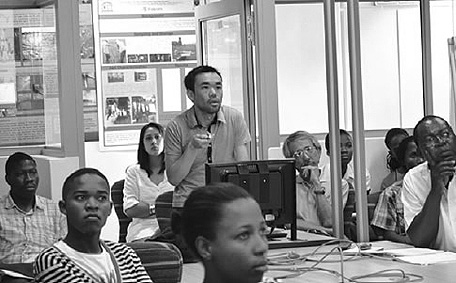
A Japanese researcher lectures at the University of the Western Cape (Photo: JICA)
Notes:
(11) REDD: Reducing Emissions from Deforestation and Forest Degradation, in Developing Countries
